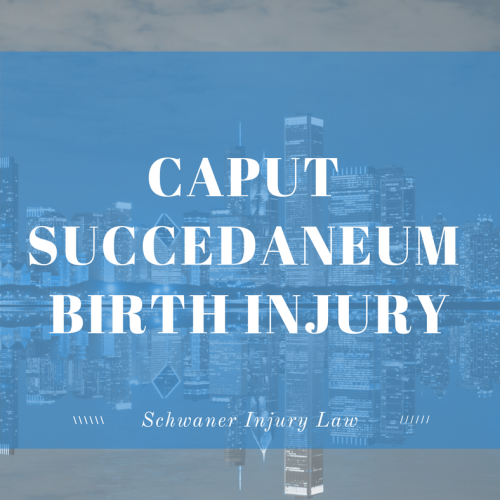
Chicago Caput Succedaneum Birth Injury Guide
Caput succedaneum, often shortened to caput by doctors, is a birth injury most often caused by the pressure of the cervix against the scalp, causing bleeding beneath the scalp.
It is a common birth injury that occurs in up to 2.5 percent of all births.
The condition is marked by swelling, puffiness, and bruising of the scalp – a result of the leaking of serosanguineous fluid that causes edema or bruising – that may leave the head looking misshapen.
While most cases resolve themselves quickly, usually within the first few days following birth, complications are possible, despite most medical professionals being quick to downplay the seriousness of the condition.
What Causes Caput Succedaneum?
Table of Contents
A caput succedaneum is most likely to form during a complicated delivery, and it is especially common if the amniotic sac has broken, and the amniotic fluid is no longer producing cushioning to protect the baby’s head.
While prolonged pressure on the baby’s head during childbirth due to a lack of amniotic fluid is the most common cause, it is not the only one.
Other reasons why a baby might be born with caput succedaneum include:
- A long, difficult labor that involves lots of pushing or strong contractions caused by the administering of drugs to induce labor.
- An attempt at a vaginal birth when the baby is too large to be comfortably delivered vaginally.
- Vacuum extraction during a difficult, complicated delivery. Forceps-assisted deliveries are also a risk factor for caput succedaneum, but vacuum extraction has a higher risk factor due to the suction used to help in the birthing process.
In some cases, such as when the membranes of the amniotic sac rupture early, leaving little or no amniotic fluid as cushioning, symptoms of caput succedaneum can be detected by ultrasound prior to the beginning of labor or delivery, which would suggest a cesarean section to help prevent additional damage, including the death of delicate tissue.
Caput Succedaneum Birth Injury Chicago, Illinois
If your loved one experienced Caput Succedaneum Birth Injury we can help. Get in touch with our team today for a free Caput Succedaneum Birth Injury consultation.
What Are the Symptoms of Caput Succedaneum?
There are a variety of symptoms that immediately suggest caput succedaneum, including:
- Soft, puffy swelling of the scalp that resembles adult edema.
- Bruising or a change in color of the scalp where swelling is present.
- Swelling that extends to both sides of the baby’s scalp.
- Swelling at the region of the head that presented first during childbirth.
- Increased molding of the bones of the baby’s head, which could result in a slight point to the baby’s head, caused when the bones were under too much pressure. (Because the bones of a baby’s head are not yet fused, and won’t be until the child turns two, they can undergo considerable movement without and lasting damage.)
Swelling can be significant, which can cause serious concerns for parents who are surprised by their baby’s cone-shaped head, caused by edema that pushes the scalp away from the bones of the skull.
How to Diagnose Caput Succedaneum
A physical exam will determine whether or not a birth injury presents as caput succedaneum, and other exams and tests are not necessary unless rare complications occur.
In almost all cases, a complete recovery can be expected, and the scalp will usually regain its normal contours after the swelling recedes.
How to Treat Caput Succedaneum
While in most cases, there is no treatment option for caput, which resolves itself on its own, the condition is painful, which will make your baby irritable.
Administering a baby-safe analgesic – your doctor will prescribe the right product and dosage – will help alleviate pain.
Because of the sensitivity, handling of your baby should be kept to a minimum for the first few days of his or her life.
Possible Complications Associated with Caput Succedaneum
While most cases of caput resolve within a few days, there is a chance of complications, including jaundice.
While jaundice is also likely to clear up after a few weeks, that doesn’t mean symptoms should go untreated.
Jaundice is a serious risk, and if it is prolonged and left untreated, it can cause elevated levels of bilirubin in the blood, which can be dangerous, especially so if those levels escalate, causing kernicterus, a type of brain damage that can include cerebral palsy, hearing loss, poor development of tooth enamel and a permanent upward gaze.
If your child develops jaundice that doesn’t improve within several weeks, contact your child’s doctor. Blood tests may be necessary to determine the underlying cause of the jaundice.
Another complication of caput succedaneum is halo scalp ring, a type of alopecia (hair loss) that could occur as a result of the death of tissue caused by prolonged pressure during the birth process. While hair grows back over time in most cases, the ring of hair loss could be permanent.
Infection is also a risk factor, especially so if doctors attempt to drain the excess fluid from the infant’s scalp.
Caput should be monitored, because edema can lead to bleeding that can damage brain cells, which can cause permanent developmental disabilities including cerebral palsy, brain damage, developmental disabilities and hearing impairment or total deafness.
What Should I Do If My Child Was Diagnosed with Caput Succedaneum?
While caput succedaneum is most often described as a pregnancy-related complication, it is just as often the result of medical negligence, and it has the potential to be deadly if doctors fail to appropriately diagnose any potential complications.
If your child was born with caput succedaneum and you believe your baby’s injury was the result of medical negligence, our team of lawyers can help.
Your initial consultation is free, and you won’t be charged unless we settle or win your case in court.












